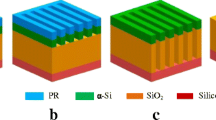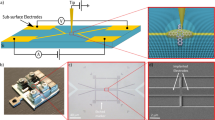Abstract
Different materials were used to optimize the desired nano-size with smooth process and faster fabrication. Gold, polysilicon and silicon were used to apply this report (experimental). SOI and Si wafers have used as a substrate and one chrome mask to build up the nanogap devices using size reduction technique. Two chrome masks have used to fabricate the proposed pattern. Electrical characterization was applied to setup the fabricated devices with different materials. Conductivity and resistivity were measured to characterize the nanogap structure with gold, polysilicon and silicon as electrodes. However, gold nanogap has recorded an increment in the conductivity, and the silicon nanogap structures have recorded an increment in the resistivity comparing with the other used materials.







Similar content being viewed by others
References
Adam T, Hashim U (2014) Highly sensitive silicon nanowire biosensor with novel liquid gate control for detection of specific single-stranded DNA molecules. Biosens Electron 67:656–661
Dhahi TS, Ali ME, Hashim U, Saif AA, Nazwa T (2011a) 5 nm gap via conventional photolithography and pattern-size reduction technique. Int J Phys Sci 6(15):3649–3656
Dhahi TS, Hashim U, Ahmed NM (2011b) Reactive ion etching (RIE) for micro and nanogap fabrication. J Basrah Res Sci 37(2):11–20
Dhahi TS, Hashim U, Ali ME, Ahmed NM (2012) Fabrication of 6 nm gap on silicon substrate for power saving appliances. Int J Phys Sci 7(16):2414–2421
Du D, Zou Z, Shin Y et al (2010) Sensitive immunosensor for cancer biomarker based on dual signal amplification strategy of graphene sheets and multienzyme functionalized carbon nanospheres. Anal Chem 82(7):2989–2995
Hashim U, Nazwa T, Dhahi TS, Saifullah A (2011) Polysilicon nanogap structure development using size expansion technique. Microelectron Int 28(3):24–30
Jemmy S, Rosemary LS, Scotts DC (2010) Fabrication of nano-gap electrodes and nano wires using an electrochemical and chemical etching technique. J Micromec Microengineering 10:1–7
Kang S, Nieuwenhuis AF, Mathwig K, Mampallil D, Lemay SG (2013) Electrochemical single-molecule detection in aqueous solution using self-aligned nanogap transducers. ACS Nano 7(12):10931–10937
Kim JH, Hanul M, Seunghyup Y, Choi YK (2012) Nanogap electrode fabrication for a nanoscale device by volume-expanding electrochemical synthesis. Small 1(2):1–7
Mampallil D, Mathwig K, Kang S, Lemay SG (2014) Reversible adsorption of outer-sphere redox molecules at Pt electrodes. J Phys Chem Lett 5(3):636–640
Singh KV, Bhura DK, Nandamuri G, Whited AM, Evans D, King J, Solanki R (2011) Nanoparticle-enhanced sensitivity of a nanogap-interdigitated electrode array impedimetric biosensor. Langmuir 27(22):13931–13939
Zanetti Ionescu C, Nevill JT, Di Carlo D, Jeong KH, Lee LP (2006) Nanogap capacitors: sensitivity to sample permittivity changes. J Appl Phys 99(2):024305
Zhong Z, Wu W, Wang D et al (2010) Nanogold-enwrapped graphene nanocomposites as trace labels for sensitivity enhancement of electrochemical immunosensors in clinical immunoassays: carcinoembryonic antigen as a model. Biosens Bioelectron 25(10):2379–2383
Author information
Authors and Affiliations
Corresponding author
Rights and permissions
About this article
Cite this article
Dhahi, T.S. Nanogaps formation and characterization via chemical and oxidation methods. Microsyst Technol 22, 817–822 (2016). https://doi.org/10.1007/s00542-015-2454-2
Received:
Accepted:
Published:
Issue Date:
DOI: https://doi.org/10.1007/s00542-015-2454-2




